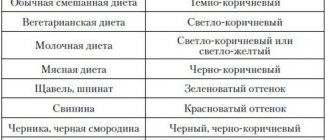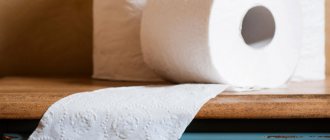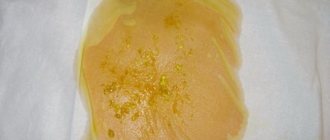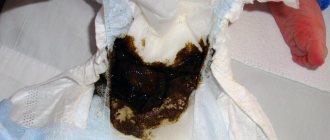New mothers are often ridiculed for talking about the color of their baby's stool. But it’s not for nothing that the peculiarities of a child’s stool are the subject of excited discussions among parents. Those who laugh apparently don’t realize that the color of stool is an important diagnostic criterion. Like a litmus test, it shows the condition of the baby's intestines. Not only the color of stool, but also its structure shows what is going on in the child’s body.
The baby has diarrhea! What to do? Of course, you should not make a diagnosis on your own and self-medicate. But, as you know, knowledge is power. It is important to understand what happens in a child’s body and what causes green diarrhea in an infant. Therefore, it is worth understanding how the intestines work.
Intestines in infants
The child's digestive system consists of the oral cavity and pharynx, esophagus, stomach and intestines. Regurgitation occurs in children for the reason that the entrance sphincer is not yet fully developed. The components of gastric juice in newborns are the same as in adults, only their concentration differs. But by 4 months there are more enzymes, and their activity increases. The capacity of the stomach at birth is only about 30 ml, and by the year it increases significantly and reaches 250-300 ml.
In newborns, bowel movements occur after every meal. The first bowel movements of newborns are not associated with food. In the fetal intestine, the epithelium is already being renewed and various secretions are released, albeit in small quantities. Mixing with dead cells and swallowed amniotic fluid, they form the original feces - meconium. It is dark green in color immediately after birth. In the first days it turns brown, then lightens and acquires the usual golden-yellow color of “childish surprise.” Later, children have dark green stool or even diarrhea. This can be both normal and pathological, which should be examined in more detail.
There are no microorganisms in the fetal intestines yet; they have nowhere to appear. They colonize the digestive tract when passing through the birth canal, and then through the mouth upon contact with objects. After all, babies love to put everything in their mouth!
The baby's intestine has a greater relative length than that of an adult. Its walls are very permeable, so in case of any intestinal diseases in infants, intoxication quickly occurs. Intestinal absorption in children is more intense, but the protective functions are weaker. Through the intestinal lining, microbes and toxins enter the blood more easily. This is why gastrointestinal infections and poisoning are so dangerous for infants.
Breastfeeding affects the microflora in such a way that beneficial bifidobacteria predominate. But with artificial feeding and transfer to complementary foods, there are more (conditionally) pathogenic E. coli.
Prevention
In the first days of his life, the child’s body gradually adapts to the conditions around him. The baby’s digestive system is too delicate and sensitive, so any innovations in nutrition immediately affect its functioning. Doctors recommend:
Introduce new foods into the child’s diet gradually, grinding them to a puree. Wash vegetables and fruits thoroughly. Nursing mothers should carefully and in small doses consume foods that have a laxative effect. If possible, avoid the use of strong medications, especially antibiotics. Feed your baby at the same time. Do not allow your baby to eat unhealthy foods. Carefully monitor the child’s hygiene (an intestinal infection can enter the body through the hands that the baby puts into the mouth).
A child with wide open eyes enters a new world for him. He is too defenseless and trusting, he does not yet know its laws, he is still unfamiliar with pain and suffering. And his parents should, if possible, protect the baby from dangerous situations, including severe intestinal diseases.
It depends on how fit, strong and healthy he will enter adulthood.
Children at risk
Who most often has problems with the stomach and intestines?
Gastrointestinal disorders occur in premature babies. At birth, their digestive tract is not yet ready for full-fledged work. In particularly difficult cases, nutrients are administered to the baby intravenously. These babies often lose weight at birth. Later, they often experience digestive disorders typical of infants, for example, regurgitation, diarrhea, constipation.
Children born with perinatal encephalopathy often have these problems too. It would seem, what does the brain and intestines have to do with it? However, oxygen starvation during childbirth affects the entire body. Immunity develops more slowly, and at this time dysbiosis may develop, in which green diarrhea is common. The neuromuscular system of the intestines is also not yet developed, which is why the same constipation, diarrhea and bloating occur.
There are also congenital disorders in the digestive system. For example, the gallbladder may have changes in shape or bridges that will prevent it from working properly, affecting the digestion of food. Indeed, despite the fact that food does not pass through the gallbladder, it plays an important role in digestion. Bile helps emulsify fats.
Artificial feeding also becomes a risk, especially if the formula is chosen incorrectly. When bottle-fed, babies generally experience diarrhea more often. Some formulas are simply cheap and of poor quality, but sometimes the baby’s body does not accept even a high-quality one. Of course, diarrhea can occur in infants during breastfeeding.
Diarrhea in infants with complications
Diarrhea in a child can be complicated by nausea, vomiting, fever, stool may be green or contain streaks of blood and mucus.
Diarrhea in an infant with fever
An increase in body temperature with diarrhea of more than 38 0 C is a serious symptom that may be evidence of dehydration. In this case, you cannot do without medical help.
Green baby diarrhea
Stool that has a greenish tint is not yet a reason for concern when it comes to infants in the first 2 months of life. If the baby is older, then focusing only on the color of the stool also does not make sense; it is more correct to pay attention to the general well-being of the baby; if no changes occur in it, then everything is fine. When the child’s behavior changes, he shows anxiety and others, then contact your pediatrician, as green stool may be caused by:
- Lactase deficiency, which requires appropriate research;
- Colds and viral diseases.
Diarrhea in infants with vomiting
If diarrhea is accompanied by vomiting, it is usually caused by viruses. Firstly, in order to prevent such a development of the situation, mothers should wash their hands more often, especially before direct contact with the baby. The fact is that viral diarrhea is easily transmitted. If the situation does not change after several meals with the baby, then it is necessary to urgently consult a doctor, as the risk of dehydration increases sharply.
Diarrhea with nausea and vomiting can accompany a cold, gastrointestinal infection, or be a reaction to changes in diet and antibiotics.
When it comes to infection of the intestinal mucosa, one cannot count on a quick recovery.
Diarrhea in infants with mucus
Parents should immediately be reassured that if there is a small amount of mucus in the baby’s stool, there is no need to worry too much, as this may be a protective function of the intestines from acids and alkalis. But when mucus appears in the stool in the form of separate fragments, they can become a cause for concern. And if there are also blood spots and a stench, then we can talk about dysbacteriosis.
It is likely that the cause of mucus is:
- Lactose deficiency;
- Allergic reactions to certain types of foods;
- Unsterile breast milk;
- Colds, etc.
To find out the true cause of diarrhea, a medical examination is necessary.
November 23, 2015
The manifestation of diarrhea is always an unpleasant symptom, but green diarrhea in infants is of particular concern to mothers and fathers. Parents' anxiety is understandable, however, the primary factor should be the general condition of the baby.
Reasons related to diet type
Normally, a newborn's stool should be slightly liquid and light brown in color. However, you can’t give it an assessment right away. The number of bowel movements per day, the consistency and color of stool can be assessed no earlier than 5 days after birth.
Depending on the type of food the baby eats, the following causes of green stool are identified:
- Breast-feeding. While feeding with foremilk, the baby may have green stools. This is due to the fact that, unlike the back one, it is non-greasy and quickly digestible. The dark green color of stool may indicate an increase in bilirubin content, which is normal for a newborn baby. Its excess is excreted from the body along with feces. In addition, the green color of the stool may be due to hormones in breast milk and the diet of the nursing mother: the more plant foods she eats, the greener the baby's stool will be.
- Artificial feeding. The physiological norm for artificially assisted children is considered to be yellow stool. It can acquire a greenish tint if there is an increased iron content in the mixture. In addition, switching to another milk formula can also cause yellowish-green stools and an allergic reaction in the infant. That’s why it’s so important to discuss such issues with your pediatrician.
- Lure. At about six months of age, the baby begins to feed complementary foods. The baby begins to receive adult food, his digestive system adapts to digesting new foods. During this period, disruptions in the functioning of the gastrointestinal tract are common, which can manifest themselves in the form of green diarrhea.
Return to contents
Other causes of green stool
Green diarrhea in an infant may be associated with the following:
- Lactase deficiency. The number of enzymes, as well as their activity, influence the activity of the gastrointestinal tract of the infant. Green stool in babies is often associated with a lack of them. First of all, this relates to a deficiency of lactase, which is responsible for the breakdown of milk sugar in the intestines. If a baby is fed with foremilk, the level of the enzyme in the stool increases. The consistency of the stool becomes thinner and acquires a greenish tint. Lactase deficiency can also occur during formula feeding. In such cases, experts may recommend the use of low-lactose mixtures. If this problem is suspected, the doctor may order a stool test to check the level of the enzyme, after which its dosage will be prescribed. Such therapy should be carried out in a short time: the baby’s body should be given a little help, but there is no need to do the work for it, since this can lead to enzyme addiction. In addition, it should be remembered that taking enzymes can cause a reaction in the body in the form of constipation, diarrhea or allergies.
- Dysbacteriosis. Dark green feces may be a manifestation of dysbacteriosis, when the quantitative and qualitative composition of the microflora is disrupted. This often happens due to the use of antibiotics. Improper nutrition, a decrease in the body's defenses, and allergic reactions can also make changes to the balance of beneficial/pathogenic microflora and affect infants, in particular their health.
- Viral and bacterial infections. Infection of an infant with bacteria, such as Staphylococcus aureus, E. coli, salmonella, etc., occurs through contact with a carrier of the infection, through the consumption of stale food, and unwashed hands. Green diarrhea can be caused by viral and enteroviral infections, which can occur in the form of gastroenteritis.
Return to contents
Danger of condition
One of the undesirable consequences of diarrhea is dehydration, which poses a danger to the baby.
The more intense the dehydration, the higher the child’s temperature rises and, accordingly, the situation becomes even more complicated.
Vomiting, bloating, and pain often accompany green diarrhea and cause serious anxiety to the baby. His eyes become sunken, his limbs become cold to the touch. The baby is capricious and restless. Such symptoms should be a reason to call emergency medical services. Severe dehydration can be fatal. This condition is especially dangerous for infants who are under 6 months old. This is due to the fact that they do not drink water well, and this impairs the process of replenishing fluid in the body. Therefore, if a child, in addition to green diarrhea, experiences general poor health, parents should consult a specialist.
There are times when the color of a baby’s stool worries the mother more than the baby himself. For personal peace of mind, parents can take a bacteriological analysis of his stool and do a culture of the intestinal microflora. Such tests are prescribed by a doctor at a regular children's clinic. If the examination shows the result is within normal limits, and the baby’s mood confirms this, then there is no point in worrying about the color of the stool. If pathogenic pathogens are identified, the specialist will prescribe appropriate treatment.
Thus, it is important to monitor not only the frequency of stool, but also its color, smell, and the presence of impurities. If such symptoms are accompanied by poor health of the baby, it is important to immediately seek medical help.
Rate this article:
Loading…
Despite the fact that green diarrhea occurs quite often in infants, parents cannot always be sure that they know why it acquired this color. Due to lack of awareness, they begin to worry prematurely, or, conversely, do not pay attention to the child’s alarming symptoms.
Most often, green diarrhea in infants is caused by an intestinal infection; in addition to diarrhea, in this case the child develops pain in the abdomen and a fever. If all these ailments are noticed, you should call a doctor and begin treatment. However, infection is not the only reason why your baby's stool may change color.
Other causes of problems
Do not overfeed your child. The baby’s digestive system simply cannot cope with excess food, which will cause disturbances in its functioning. In addition, this can provoke allergies to the most common foods. The fact is that incompletely digested food components can be absorbed into the blood and the body will take them with hostility. This causes diathesis and other allergic reactions.
Disturbances in the functioning of the gastrointestinal tract can occur if complementary foods are introduced incorrectly. Pediatrics does not stand still and new research shows that outdated standards are harmful to children's health. For example, it was customary to introduce complementary foods at just 2-3 months. The most suitable time for this time is 6 months. Also, fruit purees and juices, which have always been used for this purpose, are not so harmless. They are highly acidic, so they have an aggressive effect on the baby’s stomach and intestines. They can also cause green diarrhea. In addition, children like the sweet taste; they quickly get used to it and after that they may not have any interest in less sweet foods. So it’s best to start with vegetable purees and cereals.
Associated symptoms
If the toddler has certain health difficulties, green and watery stool in the baby will not be the only symptom. The clinical picture will certainly be supplemented by accompanying symptoms:
- Temperature. Elevated temperature with diarrhea is a marker of salmonellosis or dysentery.
- Consistency of stool. Foam in a baby's stool is one of the surest indicators of intestinal infections, in particular dysbiosis. Mucus without blood in green stool indicates salmonellosis, and with blood - dysentery.
- Color. If the shade of a child’s stool is dark green, this indicates the presence of salmonellosis; if it is light, this indicates an intestinal disorder.
- Smell. Dysbacteriosis is indicated by the sour smell of feces, and an intestinal infection by a fetid and almost unbearable odor.
- Vomiting and regurgitation. Frequent regurgitation and vomiting with green diarrhea are obvious symptoms of dysbiosis. Vomiting may be a sign of salmonellosis or dysentery.
Pathology and norm
The following signs are considered pathological: loose stools more than 20 times a day, its watery consistency, constant foamy bowel movements, green diarrhea in infants, liquid and with a pungent odor, bloody impurities, brown and greenish mucus.
You don’t have to worry if you occasionally experience foamy discharge, green spots, clear mucus, and loose stools sometimes or once.
It is important to establish the causes of the disease. After all, the causes and treatment of diarrhea in infants are closely interrelated.
How to alleviate a child's condition
Liquid green stool in a bottle-fed or breastfed baby can cause dangerous diseases. In case of acute forms of illness, seek help from specialized clinics. Doctors will carry out laboratory diagnostics of stool cultures. The analysis will reveal parasites, infections, and the state of intestinal microflora. The collected biomaterial is placed in a clean container and stored in the refrigerator.
Diagnostics of the collection makes it possible to determine the causes of the development of pathology. Comprehensive treatment of the disorder is prescribed. In most cases, doctors prescribe medications:
- "Bifidumbacterin". The probiotic improves the intestinal microflora. Many bifidobacteria increase metabolic processes in cells and increase the synthesis of vitamins. The stool will no longer turn green.
- "Lactobacterin". The chemical contains acidophilic bacteria. The medicine acts on pathogenic structures. The quality of metabolic processes increases. The child will diarrhea less often.
- "Hilak Forte". The drug establishes balance in the intestines. The prebiotic is approved for use during pregnancy and lactation.
- "Linex". The combination medicine includes 3 types of beneficial bacteria. The substance reliably eliminates flatulence, constipation, and yellow-green diarrhea.
- "Acipol." A classic probiotic product includes lactobacilli, polysaccharides, and auxiliary elements. Dark green diarrhea will be eliminated. Treat the patient systemically.
Green sour diarrhea in infants of mild and moderate forms can be eliminated at home. Activated charcoal helps by consolidating toxins and removing them from the body. The mucous layer decreases. An effective option is strong chamomile tea, which improves intestinal motility. Rice water won't hurt. The grains should be completely boiled. The mixture is given 125 ml every 120 minutes.
A popular option is hawthorn decoction. 15 g of dried fruits are diluted with 250 ml of purified water. The mixture is simmered over low heat for 8-12 minutes. The healing elixir is given to the baby 4-5 tsp. every 8 hours. During the treatment process, the condition of the monthly child is monitored. The greenish tint should change!
At high temperatures, an antipyretic is taken. Do not experiment at home. Consult a doctor at the clinic.
Infections
Green diarrhea and fever are most often signs of infection. Typically, in this case, an acute attack of diarrhea occurs - loose stools more than 12 times a day. If there are signs of abdominal pain, fever, and possibly vomiting, call a doctor. In the meantime, you need to give the child electrolytic solutions.
Dehydration can be very dangerous for infants. It can lead to seizures. Therefore, it is important to recognize its signs. This is lethargy, sunken fontanel, dry lips, rare urination, dark urine with an unpleasant odor. In this case, you need to call an ambulance and put on an IV.
The causative agents of intestinal infections can be pathogenic bacteria, fungi, viruses, and parasites. Babies do not tolerate intestinal infections well, so don’t be afraid to call an ambulance!
The green color of stool in infants may be associated with the development of enzyme production, which is not a disease, but it should not be liquid and frequent.
How to react to green diarrhea
If the green stuff in the baby’s excrement is not accompanied by a sharp deterioration in the general condition and accompanying symptoms, then you just need to constantly monitor the baby and contact your local doctor to examine the child. You also need to undergo all the necessary tests to exclude the possibility of serious diseases. If during diarrhea the baby complains of abdominal pain or there is fever, vomiting and bloating, then you should immediately call an ambulance. In any case, you should not carry out unprofessional treatment, this can lead to serious negative consequences. Also, if a child’s diarrhea turns green during teething, this may simply be caused by a decrease in immunity. In such cases, the doctor can simply prescribe medications that increase the body’s protective functions and this will allow the baby to cope with these serious processes.
The health of newborns worries many parents, and they often do not know what to look for and how to react to any changes. If this article helped you understand the issue of green stool in your baby, then recommend it to other users by sharing it or liking it.
Dysbacteriosis
The next cause of green diarrhea in infants may be intestinal dysbiosis. This happens when the balance of beneficial bacteria in the intestines is disrupted, and pathogenic microbes begin to multiply intensively. This causes not only diarrhea, but also bloating and allergic reactions. Dysbacteriosis can be accurately determined using stool analysis. In this case, doctors usually prescribe antibiotics and bacteriophages to fight harmful bacteria and probiotics to populate the intestines with beneficial microorganisms. Breastfeeding can prevent this disease. Unfortunately, this is not always possible. For such cases, there are fermented milk mixtures.
What causes the disorder?
Diarrhea in a child
The normal color of stool is light brown. An infant's stool is most often liquid and sometimes foamy; there may be impurities in the form of mucus or a small amount of blood. The stool smells sour. It can turn green due to infection or for less serious reasons.
Stool tends to oxidize when exposed to oxygen, so it may turn greenish if it has been in the diaper for some time before being detected. In addition, some green foods, such as zucchini or cucumbers, can change the color of your baby's stool. Some medications also have a similar coloring effect. Some of them increase the iron content in the body, which causes more of it to be excreted, which means that feces are more oxidized, while some disrupt the child’s intestinal microflora. In turn, this makes loose stools similar to those caused by an intestinal infection.
Dysbacteriosis also leads to the same consequences, which does not need to be specifically treated, since the imbalance of bacteria in the child’s intestines is absolutely normal. In infants, the intestines are underdeveloped, and the number of bacteria is not regulated. But the body is able to adjust itself (if there are no pathologies, but doctors announce this immediately after birth), and there is no need to help it with this with medications. Moreover, such interference can disrupt natural processes and even prolong dysbiosis. An imbalance can be caused by supplementation (transferring a child from milk to water), since water is not yet absorbed sufficiently.
Interestingly, green diarrhea can appear not only due to an imbalance of bacteria, but also due to insufficient hindmilk intake. The milk in the breast is subject to the same laws of gravity as everything else, and therefore milk, which is fattier and richer in nutrients, ends up in the lower part of the breast, and the front, lighter and less fatty milk ends up at the top, closer to the nipple.
During feeding, the baby first drinks foremilk, and then hindmilk; its different richness makes the child's meal similar to a regular meal - first light foremilk, as an aperitif, and then heavier hindmilk, as a main course. Women like to change breasts often, and feed the baby from one or the other. It turns out that the baby drinks only foremilk, the supply of which in the breast is replenished as it returns from one to the other. Due to a lack of nutrients, the baby's diarrhea turns green, and he gains weight poorly.
Green diarrhea often appears in children who are bottle-fed, which is explained by the high iron content in formulas. An incorrectly selected mixture significantly disrupts the processes in the child’s body. Overfeeding, complementary feeding, and poor diet by the mother (mayonnaise, fatty foods, alcohol, etc.) can also lead to the disorder. All this contributes to bloating, so it is quite easy to determine the wrong diet.
If a child’s disorder is caused by poor nutrition, then you should definitely consult a doctor so that he can adjust the diet.
What do doctors prescribe?
Are all mothers worried about what to give their babies for diarrhea? Any treatment must be agreed with a doctor.
Firstly, drinking plenty of fluids is important. This can be plain water, rehydron or children's tea. If your baby refuses to drink or is nauseous, you can try giving him small amounts of water. If he does not take fluid at all, a glucose-saline solution is administered intravenously.
Children's teas for diarrhea are best based on fennel or chamomile.
Probiotics are also prescribed to normalize the intestinal microflora. Probiotics can be available in dry or liquid form. They are also divided into different groups (depending on the components). There are products that include only one type of bacteria, for example, Bifidumbacterin, Lactobacterin. Some include a mixture of beneficial microorganisms, for example, Bifiform or Linex, and still others contain other additives that enhance the effect of bacteria. These are drugs such as Acipol and Bifiliz. Newborns from the first days are shown such probiotics as Bifiform Baby, Normoflorin-L (lactobacteria), Normoflorin-B (bifidobacteria and prebiotic lactitol), Narine.
In the case when an infection or dysbiosis is diagnosed, in which the intestines are colonized by pathogenic microbes, antibiotics are prescribed. Nifuroxazide is considered one of the most harmless drugs.
And enzyme preparations (for example, Creon) are prescribed if the disease is associated with enzymatic deficiency. They are also used for infections, because they disrupt all processes in the intestines.
The doctor may advise normalizing the nutrition of a nursing mother. If diarrhea occurs in a baby during artificial feeding, then a suitable formula for feeding is selected.
What should parents do?
The direction of activity of adults depends on the cause of green loose stools and the severity of the consequences. An outwardly healthy, cheerful, active baby who suddenly poops green requires observation. You can keep a diary where the mother will record the temperature during the day, the number of feedings, periods of sleep and wakefulness. The color, consistency, smell of feces, and their frequency should be reflected. Keeping records will clearly show when the changes began and how they grew.
If the child walks with liquid, almost water, with inclusions of mucus and blood, and fever and vomiting are noted, then it is necessary to call a doctor. This condition is fraught with complications due to rapid dehydration and loss of electrolytes. This poses a threat to the health and life of the baby. Treatment at home consists of replenishing the volume of lost fluid and restoring salt balance. Regidron bio is produced especially for children. The amount of salts there is less, but there are probiotics and prebiotics for the rapid growth of beneficial microflora. A sachet of the product is dissolved in a liter of cooled boiled water and 50 ml is drunk as often as possible.
When giving this medicine, parents must be sure that the child does not have diabetes, liver or kidney diseases, or high blood pressure.
Congee
Rice water has several beneficial effects on the baby's digestive system. Firstly, it is viscous and sticky and coats the walls of the stomach and intestines. This gives an anti-inflammatory effect. It also absorbs excess fluid and reduces intestinal motility. This decoction is easy to obtain. Boil a tablespoon of rice in a glass of water for about 40 minutes. It should be taken warm, 2-3 sips every 2 hours.
Possible reasons
Why might a child develop green diarrhea? The reasons can be very different, they depend on the diet, age and health of the baby.
As soon as you notice this unpleasant phenomenon, you first need to try to understand why it happened. Some provoking factors are normal and should reassure parents, while others will indicate problems that will have to be resolved in the doctor’s office.
Reasons that should not cause concern
- Meconium
The peculiarity of the stomach in the first 10 days of a child’s life explains the dark olive color of the stool.
- Formation of the gastrointestinal tract
A greenish tint in the first year of life during breastfeeding is due to the underdeveloped gastrointestinal tract in newborns. Over time, his work returns to normal.
- Breast-feeding
The liquid consistency is a consequence of the baby’s absorption of the mother’s fore-milk, low-fat breast milk.
- Features of the mother's breast
If at 1 year of age the stool remains the same liquid and green, this may be due to tight breasts or inverted nipples in the mother. In this case, the formation of stool may take longer.
- Maternal nutrition during breastfeeding
If a nursing mother’s diet contains a lot of carbohydrate-containing foods and green vegetables (you can find the nursing mother’s menu here), this can cause green diarrhea in the baby. It can be caused by spinach, broccoli, parsley, dill, green apples and pears, and cucumbers.
- Artificial feeding
The use of milk formulas with a high iron content: NAN, Nutrilon and others.
- Introduction of complementary foods
The first acquaintance with foods such as apples, broccoli, pears, and sweet porridge can lead to a change in the color of children's feces.
- Nutritional Features
In older children (3-5 years), when the gastrointestinal tract is already fully formed, green diarrhea can be a consequence of poor nutrition. Namely: excessive consumption of carbohydrates (chocolate, sweets, baked goods, confectionery) and green foods (apples, pears, sorrel, dill, parsley, onions, spinach, lettuce).
Dangerous reasons
- Dysbacteriosis due to improper introduction of complementary foods, previous intestinal infection, somatic disease, which were treated with antibiotics.
- Intestinal infections: shigellosis, escherichiosis, yersiniosis, rotavirus infection, campylobacteriosis and others.
- Dysentery.
- Salmonellosis due to consumption of raw or poorly thermally processed chicken eggs and fish.
If a child has green diarrhea, this fact cannot be ignored. It is necessary to carefully analyze the situation and draw initial conclusions about what could have caused such a stool.
If they are related to age characteristics and nutrition, and fit into the norms, there is no need to worry. But if you suspect a health problem, you should consult a doctor immediately. The accompanying symptoms will help clarify the situation.
Diet for diarrhea
You can roughly imagine what an adult or a child who has completely switched to adult food should eat if they have diarrhea. What advice can you give to a baby? If a baby has diarrhea while breastfeeding, breast milk is the best food for him. You need to feed your baby more often, but in small portions. This will both prevent dehydration and prevent overloading the upset intestines. If the baby is already receiving complementary feeding, then you can temporarily refuse complementary feeding and leave only milk or medicinal formula in his diet. When artificially feeding, they switch to low-lactose formulas.
Diarrhea in infants - causes
It should be clarified that the occurrence of diarrhea is initially facilitated by the anatomical and physiological characteristics of the infant body. This is due to the fact that children have longer intestines than adults, and the cecum is more mobile. As a result, serious complications develop much faster in their body and can be expressed in electrolyte imbalances, dehydration and other health disorders.
Some of the causes of diarrhea in infants include:
- Eating disorders. When the baby is breastfed without additional complementary feeding, the mother should be more attentive to her own diet and be wary of innovations in it. As soon as the mother switches to a gentle diet, the baby’s stool returns to normal on its own.
- Often, some new product not only in the mother’s diet, but also in his own can cause digestive upset in a baby. For example, whole milk, products containing cereal gluten.
- Diarrhea can be a consequence of the introduction of complementary foods in the form of plant foods (vegetables and fruits).
- The greatest danger is caused by diarrhea caused by intestinal infections caused by viruses and bacteria that enter the body along with low-quality products.
- Another reason for the appearance of diarrhea in children may be the use of antibiotics, iron supplements and antifungal drugs, and then we are talking about dysbacteriosis.
Diagnosis and treatment
The doctor will determine the cause of diarrhea after talking with the parents and examining the baby. It may be necessary to undergo additional examination to clarify the diagnosis.
Diagnostics
It is difficult to determine the true cause of diarrhea based on the color and consistency of stool alone. Sometimes the doctor prescribes tests:
- Bacterial analysis of stool is an informative research technique that identifies pathogenic microorganisms.
- General blood analysis.
- Blood test for intestinal infections.
- General urine analysis.
- Stool analysis.
Ultrasound of the baby's peritoneum
Perhaps the reason lies in the pathology of the internal organs. In this case, the doctor prescribes ultrasound diagnostics of the abdominal organs.
Treatment
When the cause of green diarrhea is clarified, the doctor prescribes treatment. For dysbacteriosis, Linex, Bifidumbacterin, Enterol can be prescribed. The main task is to eliminate the disease that caused the symptom.
Intestinal infection requires complex treatment. First, the type of pathogen is identified using tests. Then a diet is prescribed. In difficult cases, antibiotic therapy is performed. The doctor prescribes bactericidal drugs.
To replenish the water-salt balance, Regidron may be prescribed.
If bowel movements are caused by poisoning, you will need to take adsorbent drugs: Smecta, Activated carbon.
It is not recommended to stop diarrhea with medications without a doctor’s prescription; harmful toxins are released with feces.
In the first month of life, the baby most likely will not need drug treatment, since the causes of green stool during this period are not pathological.
Children over 1.5 years old are recommended to have a strict diet, which excludes carbonated water, unprocessed plant foods and fatty foods.
Parents should not self-medicate; there is a high risk of complications if therapy is carried out incorrectly.
What to do?
“Enterosgel” is a sorbent for absorbing and removing toxins from the child’s body
Before going to the hospital if a child has green diarrhea, accompanied by fever, vomiting and deterioration in general condition, parents can be advised to take the following measures.
- Give the child Oralit, Regidron, Enterodes in small portions - special saline solutions are sold in any pharmacy and replenish fluid loss.
- It is not recommended to drink it with plain water: it can only make vomiting worse.
- In accordance with age, give one of the sorbents: Smecta, Polypefan, Enterosgel. They absorb toxins and promote their elimination.
- No other medications, especially antibiotics, should be given to a child with green diarrhea before consulting a doctor. This can only worsen his condition.
- Do not stop breastfeeding, but reduce the daily dose of milk by a third.
- Do not go on a fasting break for more than 6 hours.
These activities will temporarily alleviate the child’s condition. But you cannot delay calling or visiting a doctor. There is an urgent need to make a diagnosis for immediate treatment.










